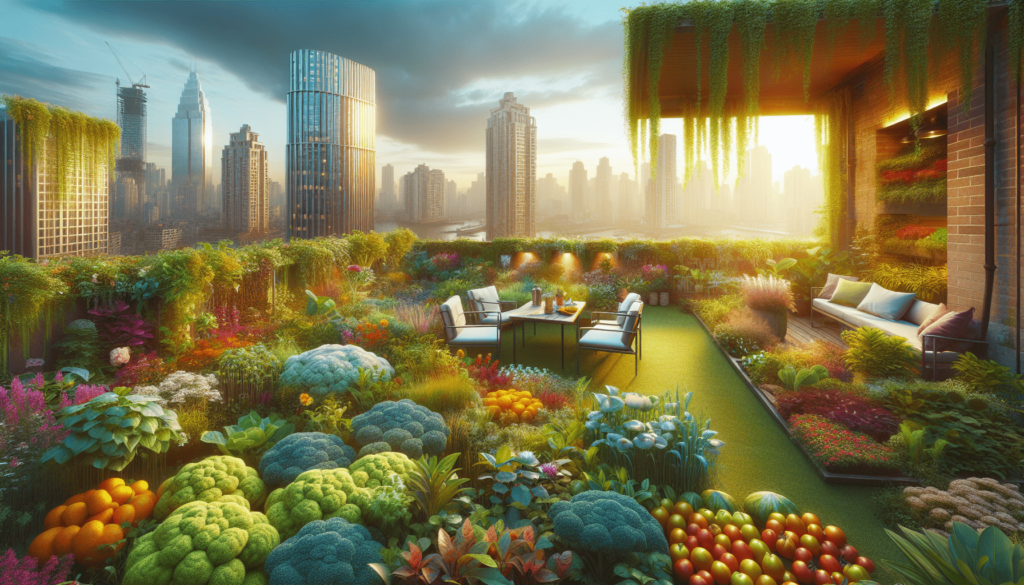Have you ever considered the untapped potential that lies above our bustling cities? While we often envision urban environments as concrete jungles, teeming with buildings and busy streets, there is a hidden world atop these structures that offers more than what meets the eye.

Table of Contents
Introduction to Urban Rooftop Gardens
Urban rooftop gardens are transforming city landscapes, turning barren roofs into lush, green sanctuaries. These gardens are more than just aesthetic wonders—they provide various ecological, social, and economic benefits. Their relevance has grown significantly as cities become more populated and the need for sustainability increases.
Thesis Statement
This exploration aims to uncover the hidden gems of urban rooftop gardens, demonstrating their importance in creating sustainable ecosystems and enhancing urban life. By examining their historical context, current trends, and future potential, this article seeks to highlight why urban rooftop gardens deserve our attention and investment.
Historical Context of Rooftop Gardens
Rooftop gardens are not a novel concept; their roots can be traced back to ancient civilizations. The Gardens of Babylon, often revered as a wonder of the ancient world, serve as one of the earliest examples. These sophisticated gardens were not only architectural marvels but also a testament to human ingenuity in utilizing limited space.
Evolution of Urban Green Spaces
Over time, the concept of green spaces evolved, with urban parks and community gardens emerging during the industrial revolution. As urbanization accelerated, the need for more innovative solutions led to the revival of rooftop gardens in the 20th century, particularly in urban centers grappling with space constraints.
Current Trends in Urban Rooftop Gardens
Today’s rooftop gardens are part of a broader movement towards sustainable living. Penetrating the very fabric of urban planning, these gardens are a testament to conscious efforts to integrate nature into metropolitan life.
Sustainable Urban Development
The current trend emphasizes sustainability. Rooftop gardens serve as key players in urban sustainability strategies, offering solutions for stormwater management, temperature regulation, and biodiversity enhancement. With numerous cities pushing green initiatives, rooftop gardens are at the forefront of this transition.
Technological Advancements
Emerging technologies are further propelling the popularity of rooftop gardens. Innovations such as hydroponics and aeroponics enable more efficient plant growth with minimal soil and water usage, aligning perfectly with urban constraints where resources are scarce.
Key Concepts and Definitions
To truly appreciate the impact of urban rooftop gardens, it’s important to understand several key concepts associated with them.
Defining Rooftop Gardens
A rooftop garden is a vegetative layer grown on the rooftop of a building. These can range from simple potted plants to elaborate ecosystems involving sophisticated soil systems and plant diversity.
Ecosystem Services
Rooftop gardens provide diverse ecosystem services, including air purification, carbon sequestration, and habitat for urban wildlife. These services contribute significantly to improving urban environmental quality.
Understanding Green Roofs
A subset of rooftop gardens, green roofs, are specially engineered systems designed to support plant life. They involve layers for drainage, insulation, and soil, effectively transforming roofs into thriving ecosystems.

Examples and Case Studies
Let’s explore how cities across the globe are embracing urban rooftop gardens, providing a glimpse of their potential impact.
Example 1: Chicago’s Green Roof Initiatives
Chicago boasts more than 500 green roofs, amounting to nearly six million square feet of greenery. The city’s innovative use of rooftop gardens showcases their potential in urban sustainability projects, particularly in handling stormwater runoff and reducing the urban heat island effect.
Example 2: Singapore’s “City in a Garden”
Singapore’s vision of becoming a “City in a Garden” is a testament to the transformative power of rooftop gardens. Their integration with urban architecture not only beautifies the city but also contributes to the well-being of its residents by providing access to green spaces.
Comparing Different Perspectives
While the benefits of rooftop gardens are manifold, various viewpoints and methodologies delineate how they are implemented across cities.
| Aspect | Traditional Urban Parks | Rooftop Gardens |
|---|---|---|
| Space Utilization | Require large land areas | Make use of existing rooftops |
| Accessibility | May need traveling by residents | Easily accessed by building occupants |
| Maintenance | Generally high | Variable, can be optimized |
| Cost | High land and installation costs | Lower relative installation costs |
| Biodiversity | Can host diverse ecosystems | Potentially limited by space |
Each approach has its unique set of challenges and benefits, shaping urban landscapes in diverse ways.

Impact and Consequences
The adoption of rooftop gardens has considerable implications for urban areas, both positive and negative. On the positive side, they aid in environmental conservation and contribute to residents’ quality of life. However, challenges such as structural feasibility and maintenance might hinder their widespread adoption.
Environmental Impact
Rooftop gardens positively impact cities by mitigating air pollution, enhancing urban biodiversity, and reducing energy consumption through natural insulation. They foster resilience against climate change by managing stormwater and reducing urban temperatures.
Economic Considerations
Economically, rooftop gardens can enhance property values and provide urban farming opportunities. Yet, the initial costs and continuous maintenance might deter some property owners, highlighting the need for supportive urban policies and incentives.
Future Directions and Implications
Looking forward, what lies ahead for urban rooftop gardens?
Predictions for Future Trends
As cities strive for sustainability, rooftop gardens will likely become a standard feature in urban planning. Innovations such as smart irrigation systems and solar panel integrations could make them more efficient and adaptive to various climates.
Implications on Society and Industry
The potential transformation is profound, with impacts on urban planning, real estate, and social dynamics. By facilitating local food production, they could significantly impact food supply chains and urban communities’ self-sufficiency.

Conclusion
In summary, urban rooftop gardens hold remarkable potential to redefine the urban ecosystem. With roots in ancient practices and relevance in modern sustainability efforts, they represent an intersection of heritage and innovation. The examples of cities like Chicago and Singapore illuminate their transformative power when leveraged correctly.
As we envision a future where cities are greener and more sustainable, the question remains: How can we further integrate these hidden gems into our urban landscape for the betterment of our cities and ourselves?
For further insights into urban sustainability initiatives, consider exploring additional resources on sustainable city development.
